VITA Zahnfabrik
H. Rauter GmbH & Co. KG
Spitalgasse 3
79713 Bad Säckingen

New veneering ceramic shows ideal light dynamics and high firing stability
Modern, all-ceramic veneering materials are required to meet a variety of criteria in terms of mechanical, esthetics and application technology. For example, they should allow for reliable reproduction of tooth shade and play of light, remain stable during the modelling process and also guarantee firing results that are dimensionally stable. Furthermore, the material is expected to ensure a good bond to conventional framework ceramic and the veneer is expected to remain stable throughout its long-term clinical use. A new veneering ceramic, VITA LUMEX AC (VITA Zahnfabrik, Bad Säckingen, Germany) has been developed, thanks to meticulous materials research that meets the wide range of expectations to a high degree. In the following interview, dental material expert Dr.-Ing. Berit Gödiker answers questions concerning VITA LUMEX AC, with regard to special material characteristics and insights gained from laboratory tests.
DV: VITA LUMEX AC is a leucite-reinforced, glass-ceramic veneering system. What are the special characteristics of the material and how can laboratories benefit from using it?
Dr.-Ing. Berit Gödiker: The leucite content of the glass allowed the new veneering ceramic to be adjusted in such a way that ensured an optimum bond to conventional all-ceramic framework materials such as zirconia and glass ceramic. In addition, leucite also contributes to high material strength, which means that excellent long-term durability can be expected with VITA LUMEX AC veneers.
DV: Shade fidelity is a central criterion forensuring that restorations integrate harmoniously into the rest of the dentition. What degree of shade fidelity, with respect to the shade standard, does the new ceramic show and why?
Dr.-Ing. Berit Gödiker: VITA LUMEX AC achieves a very high degree of shade fidelity when compared to the VITA shade standards. For a precise shade formula, you need a lot of experience, modern shade measurement technology and expert specialists. VITA has developed dental shade standards that are applied worldwide, allowing us to draw on nearly a hundred years of experience, and to familiarize ourselves with the original formulas of the shade standards. In addition, the visual analysis of shade samples in the form of material samples and restorations by experienced specialists is a key success factor.
DV: In order to achieve a vibrant play of color and light, you need ceramic material that offers the best light dynamics. What does the new veneering ceramic offer in terms of translucency, opalescence and fluorescence?
Dr.-Ing. Berit Gödiker: The degrees of translucency of OPAQUE DENTINE, DENTINE and ENAMEL materials are ideally matched to each other for an excellent play of light. Special opal materials have been developed to achieve a particularly vibrant opalescence. In addition, all of the base materials and a large amount of the effect materials exhibit nearnatural fluorescence. The highly fluorescent FLUO INTENSE materials were also designed with the aim of targeted control of in-depth fluorescence.
DV: During the modelling process, it is important for the ceramic to have good stability. What are the technical material requirements for stability, and how well does VITA LUMEX AC perform in this respect?
Dr.-Ing. Berit Gödiker: The stability of the moistened ceramic is determined by the particle shape and surface of the powder particles, as well as by the distribution of the particle size of the powder. The shape and surface of the ceramic particles must be configured in such a way that micro-serration of the particles occurs during the layering process. That is why VITA LUMEX AC ceramic particles are irregularly shaped and have a structured surface. Furthermore, VITA LUMEX AC ceramic is designed so that the fine, medium and coarse grain size components exhibit an ideal ratio to one another.
DV: The dimensional stability of the ceramic after firing is another important success factor for the laboratory. How dimensionally stable did the new veneering ceramic prove to be in your studies?
Dr.-Ing. Berit Gödiker: Material samples made of VITA LUMEX AC ceramic have been examined in countless series of tests and have always demonstrated high dimensional stability, even after repeated firing processes. The visual inspection of the test samples showed, for example, that the inserted edges do not round down. One reason for this is that with VITA LUMEX AC, the material shrinkage typical of veneering ceramic has been significantly lowered as a result of the high density, homogeneous material structure.
DV: Patients, dentists and technicians are looking for materials that offer long-term durability. What values does VITA LUMEX AC achieve in terms of mechanical properties, as compared to other materials?
Dr.-Ing. Berit Gödiker: VITA LUMEX AC exceeds the flexural strength required by the ISO standard for veneering ceramic by more than twofold, demonstrating excellent material stability in laboratory tests. In addition, the bond strength in relation to the framework material also plays an important role. Excellent bonding values were achieved with VITA LUMEX AC on both zirconia and glass-ceramic frameworks, in some cases significantly exceeding the bonding values of competitor materials.
Report 04/20
Dr.-Ing. Berit Gödiker
Bad Säckingen, Germany
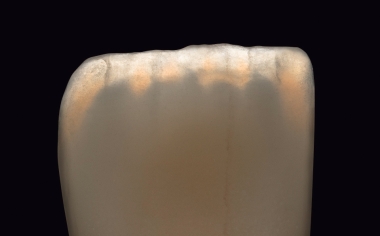
1a Opalescence
Fig 1a-c Documentation of the photo-optic properties of VITA LUMEX AC shown by photographing sample crowns using different lighting conditions and sources.
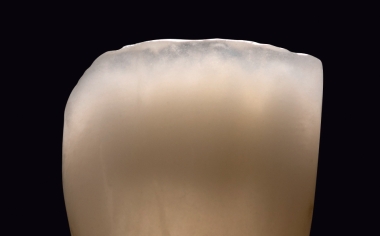
1b Translucency
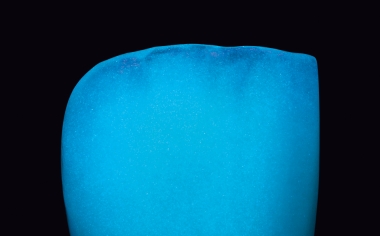
1c Fluorescence
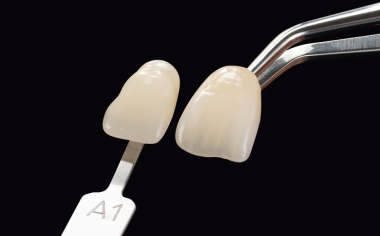
Fig 2a-b Sample representation of the visual inspection of the shade fidelity of a VITA LUMEX AC sample crown to the VITA shade standard, and for the implementation of a shade formula using ceramic powders mixed with color pigments.
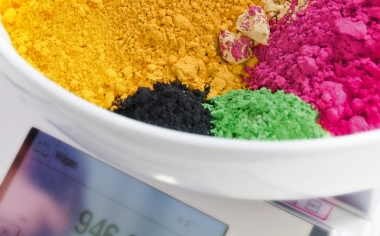
Fig 2a-b Sample representation of the visual inspection of the shade fidelity of a VITA LUMEX AC sample crown to the VITA shade standard, and for the implementation of a shade formula using ceramic powders mixed with color pigments.
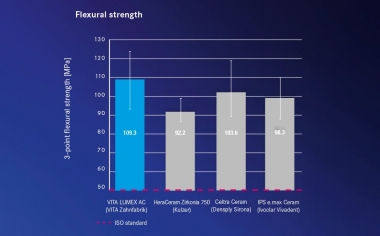
Fig. 3 Results graphic based on bending strength tests using the abovementioned all-ceramic veneering materials
Source: Internal investigation of VITA R&D, Measurement of 3-point bending strength, according to ISO 6872 with the abovementioned materials, Report 08/19, Dr.-Ing. B. Gödiker Test report is available via www.vita-zahnfabrik.com/lumex
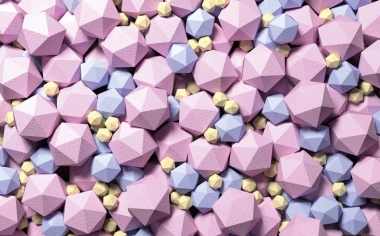
Fig. 4a-b Sample, simplified visualization of particle size distribution/micro-serration in VITA LUMEX AC, as well as sample photographic documentation of an intermediate result during layering.

Fig. 4a-b Sample, simplified visualization of particle size distribution/micro-serration in VITA LUMEX AC, as well as sample photographic documentation of an intermediate result during layering.
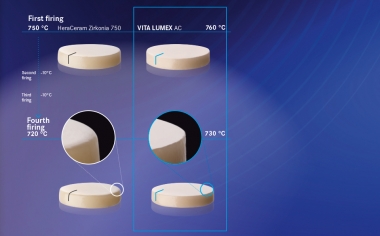
Fig. 5 Photographic documentation of the firing results of test samples of the above-mentioned veneering ceramic after several firing processes.
Source Internal investigation of VITA R&D, Analysis of firing stability after four firings with test samples of the abovementioned materials, Report 08/19, Dr.-Ing. B. Gödiker, Test report is available via www.vita-zahnfabrik.com/lumex.